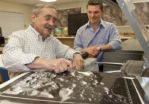(Press-News.org) AMES, Iowa – The flu virus uses a shuttle mechanism to relay protons through a channel in a process necessary for the virus to infect a host cell, according to a research project led by Mei Hong of Iowa State University and the Ames Laboratory.
The findings are published in the Oct. 22 issue of the journal Science.
Hong, an Iowa State professor of chemistry and an associate of the U.S. Department of Energy's Ames Laboratory, said her research team used solid-state nuclear magnetic resonance (NMR) spectroscopy to determine the structure and workings of the proton channel that connects the flu virus to a healthy cell.
She said a full understanding of that mechanism could help medical researchers design drugs that stop protons from moving through the channel.
That proton channel is an important part of the life cycle of a flu virus. The virus begins an infection by attaching itself to a healthy cell. The healthy cell surrounds the virus and takes it inside through a process called endocytosis. Once inside the cell, the virus uses a protein called M2 to open a channel. Protons from the healthy cell flow through the channel into the virus and raise its acidity. That triggers the release of the virus' genetic material into the healthy cell. The virus then hijacks the healthy cell's resources to replicate itself.
Hong and her research team – Fanghao Hu, an Iowa State doctoral student in chemistry; and Wenbin Luo, a former Iowa State doctoral student who is now a spectroscopist research associate at Penn State University – focused their attention on the structure and dynamics of the proton-selective amino acid residue, a histidine in the transmembrane part of the protein, to determine how the channel conducts protons. Their work was supported by grants from the National Science Foundation and the National Institutes of Health.
Two models had been proposed for the proton-conducting mechanism:
A "shutter" channel that expands at the charged histidine because of electrostatic repulsion, thus allowing a continuous hydrogen-bonded water chain that takes protons into the virus.
Or a "shuttle" model featuring histidine rings that rearrange their structure in some way to capture protons and relay them inside.
Hong's research team found that the histidine rings reorient by 45 degrees more than 50,000 times per second in the open state, but are immobile in the closed state. The energy barrier for the open-state ring motion agrees well with the energy barrier for proton conduction, which suggests that the M2 channel dynamically shuttles the protons into the virus. The chemists also found that the histidine residue forms multiple hydrogen bonds with water, which helps it to dissociate the extra proton.
"The histidine acts like a shuttle," Hong said. "It picks up a proton from the exterior and flips to let it get off to the interior."
The project not only provided atomic details of the proton-conducting apparatus of the flu virus, but also demonstrated the abilities of solid-state NMR.
"The structural information obtained here is largely invisible to conventional high-resolution techniques," the researchers wrote in their Science paper, "and demonstrates the ability of solid-state NMR to elucidate functionally important membrane protein dynamics and chemistry."
INFORMATION:
Iowa State, Ames Lab chemists discover proton mechanism used by flu virus to infect cells
2010-10-22
ELSE PRESS RELEASES FROM THIS DATE:
Putting a bull's-eye on the flu: Detailing influenza's structure for drug targeting
2010-10-22
Beating the flu is already tough, but it has become even harder in recent years – the influenza A virus has mutated so that two antiviral drugs don't slow it down anymore.
Reporting their findings in the journal Science, researchers from Florida State and Brigham Young move closer to understanding why not, and how future treatments can defeat the nasty bug no matter how it changes.
The two drugs, amantadine and rimantadine, are no longer recommended by the CDC for use against flu.
They used to work by blocking a hole in the influenza A virus called the "M2 channel," ...
Study details molecular structure of major cell signaling pathway
2010-10-22
(Embargoed) Scientists at the University of North Carolina at Chapel Hill School of Medicine have reported the exact molecular structure and mechanisms of a major cell signaling pathway that serves a broad range of functions in humans.
Up to half of drugs approved by the US Food and Drug Administration directly or indirectly target G protein-coupled receptors. These receptors, which are proteins that live in the outer membranes of cells, take molecular signals from outside the cell and convert them into responses within – and those responses help control behaviors as ...
Risk gene for severe heart disease discovered
2010-10-22
Research led by Klaus Stark and Christian Hengstenberg of the University of Regensburg identified a common variant of the cardiovascular heat shock protein gene, HSPB7, which was found to increase risk for dilated cardiomyopathy by almost 50%. Their paper appears on October 28 in the open-access journal PLoS Genetics.
Per year, about 6 in 100,000 individuals develop dilated cardiomyopathy (DCM), with a higher prevalence in men. This disease is characterized by an enlarged, weakened heart, subsequently affecting the pumping capacity and often leading to chronic heart failure. ...
Mathematical model helps marathoners pace themselves to a strong finish
2010-10-22
CAMBRIDGE, Mass. -- Most marathon runners know they need to consume carbohydrates before and during a race, but many don't have a good fueling strategy. Now, one dedicated marathoner -- an MD/PhD student in the Harvard-MIT Division of Health Sciences and Technology -- has taken a more rigorous approach to calculating just how much carbohydrate a runner needs to fuel him or herself through 26.2 miles, and what pace that runner can reasonably expect to sustain.
The result is a new model, described in the Oct. 21 issue of the journal PLoS Computational Biology, which allows ...
NASA-engineered collision spills new Moon secrets
2010-10-22
VIDEO:
Peter Schultz and graduate student Brendan Hermalyn analyzed data from bits of the Moon’s surface kicked up by a NASA-engineered collision. They found unexpected complexity -- and traces of silver....
Click here for more information.
PROVIDENCE, R.I. [Brown University] — Scientists led by Brown University are offering the first detailed explanation of the crater formed when a NASA rocket slammed into the Moon last fall and information about the composition of the ...
Stanford study links cancer to loss of protein that hooks skin cells together
2010-10-22
STANFORD, Calif. — In a study to be published online Oct. 21 in PLoS Genetics, researchers at the Stanford University School of Medicine have implicated the lack of a protein important in hooking our skin cells together in the most common variety of skin cancer. Depletion of this protein, called Perp, could be an early indicator of skin cancer development, and could be useful for staging and establishing prognoses.
These findings' significance may extend beyond skin cancer, as Perp is found in the linings of many of our internal organs, where it plays the same role it ...
Protein injection shows promise in lowering elevated triglycerides
2010-10-22
Injecting a protein that helps break down triglycerides may someday help treat an inherited form of high triglycerides, according to a new study in Arteriosclerosis, Thrombosis, and Vascular Biology, an American Heart Association journal.
Triglyceride is a type of fat in the blood. Elevated levels in the blood — hypertriglyceridemia — have been linked to coronary artery disease.
In the study, researchers tested a new compound in mice genetically altered to be deficient in a protein called apolipoprotein (apo)A-V, which causes them to have high blood levels of triglycerides. ...
Treating metabolic syndrome, undergoing carotid angioplasty
2010-10-22
Treating metabolic syndrome and undergoing carotid angioplasty may prevent recurrent stroke or transient ischemic attack (TIA), according to revised American Heart Association/American Stroke Association guidelines.
Last updated in 2006, the evidence-based guidelines for doctors will be published in Stroke: Journal of the American Heart Association.
"Patients who've had a stroke or TIA are at highest risk for having another event," said Karen Furie, M.D., M.P.H., writing committee chair and stroke neurologist. "Since the last update, we've had results from several studies ...
Younger brains are easier to rewire
2010-10-22
CAMBRIDGE, Mass. - A new paper from MIT neuroscientists, in collaboration with Alvaro Pascual-Leone at Beth Israel Deaconess Medical Center, offers evidence that it is easier to rewire the brain early in life. The researchers found that a small part of the brain's visual cortex that processes motion became reorganized only in the brains of subjects who had been born blind, not those who became blind later in life.
The new findings, described in the Oct. 14 issue of the journal Current Biology, shed light on how the brain wires itself during the first few years of life, ...
Efforts underway to rescue vulnerable bananas, giant swamp taro, other Pacific Island crops
2010-10-22
INFORMATION:
The Global Crop Diversity Trust (www.croptrust.org)
The mission of the Trust is to ensure the conservation and availability of crop diversity for food security worldwide. Although crop diversity is fundamental to fighting hunger and to the very future of agriculture, funding is unreliable and diversity is being lost. The Trust is the only organization working worldwide to solve this problem. The Trust is providing support for the ongoing operations of the seed vault, as well as organizing and funding the preparation and shipment of seeds from developing ...




